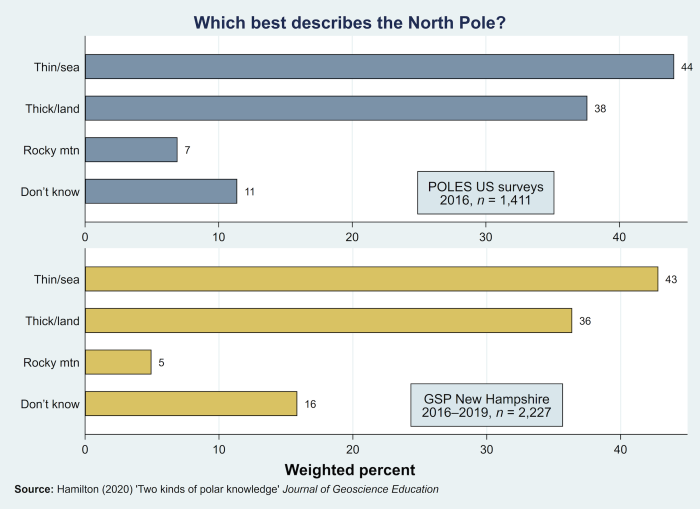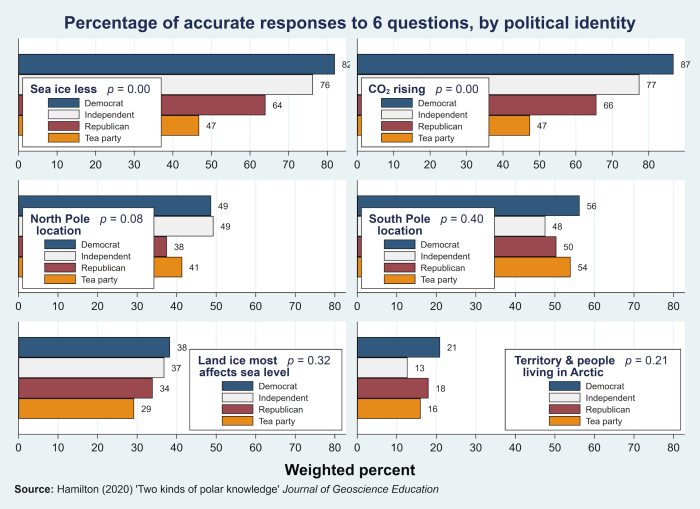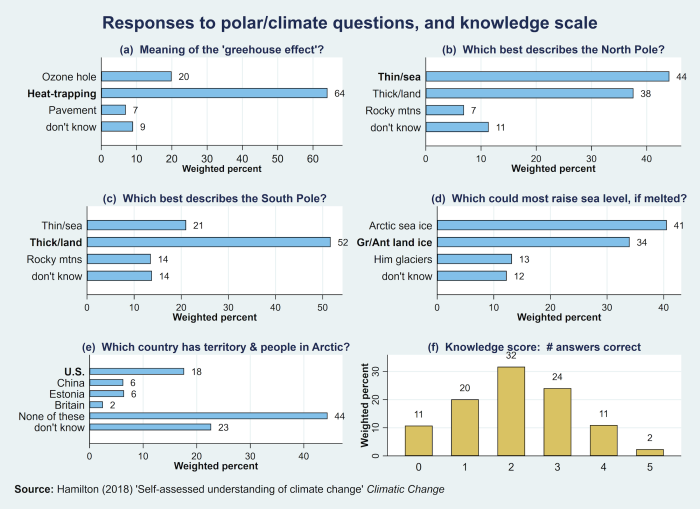By: Lawrence Hamilton, Carsey School of Public Policy, University of New Hampshire
How much does the US public know about polar regions? Researchers exploring this topic have occasionally mixed factual questions in among the more typical opinion queries on general-public surveys. A recent article in the Journal of Geoscience Education (Hamilton 2020) describes a key finding from these surveys: there are "two kinds" of polar knowledge. One kind is evoked by questions like this:
Which of the following three statements do you think is more accurate? Over the past few years, the ice on the Arctic Ocean in late summer...
- Covers less area than it did 30 years ago (correct)
- Declined but then recovered to about the same area it had 30 years ago
- Covers more area than it did 30 years ago
The declining area of late-summer Arctic sea ice, tracked by satellites over the past 40 years, is a basic and widely reported scientific fact. On surveys, however, many people do not recognize this fact, but answer instead based on their opinion about global warming. Similar results occur if we ask whether, in recent decades, CO2 concentrations in the atmosphere have increased: again, many people give answers contrary to science, but reflecting instead their beliefs or political identity. Although these questions involve important and well-established facts, survey responses defy simple interpretation as indicators of knowledge.
The second type of polar knowledge involves questions that are equally factual, and perhaps equally relevant to climate change, but have answers that cannot be guessed (right or wrongly) from one's political beliefs. For example,
Which best describes the North Pole?
- Ice a few feet or yards thick, over a deep ocean (correct)
- Ice more than a mile thick, over land
- A rocky, mountainous landscape
Opinions about global warming whisper no clues that the first answer (order is rotated on the actual surveys) is correct. Instead, a person needs to be able to visualize a globe, or to know basic geography—which, unfortunately, many do not. Figure 1 shows parallel results from nationwide and regional surveys: only about 44% could answer this question correctly. It illustrates a second type of polar knowledge, which is independent from political beliefs. Figure 2 shows the percentage of accurate responses to six factual questions, correlatd by respondent political identity
How might such belief-neutral knowledge questions be used in research? Panels a–e in Figure 3 show the responses to five questions asked on a nationwide 2016 survey (details in Hamilton 2018). Adding up the number of correct answers yields a belief-neutral knowledge score (panel f), which can be compared with people's self-assessed understanding of climate change. Among some groups, actual and self-assessed knowledge are correlated—as one might hope—but among other groups they are not related at all (Hamilton 2018; Hamilton and Fogg 2019). Another possible application of such measures involves inter-regional or international comparisons. For example, levels of polar knowledge among Australians appear quite similar to general US levels (Tranter 2019). Levels of Arctic knowledge are somewhat higher among Alaska residents compared with other US states—but even among Alaskans, barely half know that the US has territory and people above the Arctic Circle (Hamilton et al. 2017). Whatever the group differences, all of these studies confirm that general-public knowledge about the Earth's polar regions is thin, leaving much room for science communication.
References
Hamilton, L.C. 2018. Self-assessed understanding of climate change. Climatic Change 151(2): 349–362. https://doi.org/10.1007/s10584-018-2305-0
Hamilton, L.C. 2020. Two kinds of polar knowledge. Journal of Geoscience Education https://doi.org/10.1080/10899995.2020.1838849
Hamilton, L.C. and L.M. Fogg. 2019. Physical-world knowledge and public views on climate change. Presented at American Association of Geographers annual meeting in Washington DC. https://scholars.unh.edu/faculty_pubs/648/
Hamilton, L.C., J. Wirsing, J. Brunacini and S. Pfirman. 2017. Arctic knowledge of the US public. Witness the Arctic (1 May 2017). https://www.arcus.org/witness-the-arctic/2017/5/highlight/2
Tranter, B. 2019. Does public knowledge of climate change really matter in Australia? Environmental Communication 14(4): 537–554. https://doi.org/10.1080/17524032.2019.1696853
Acknowledgments
The research described here was supported by grants from the US National Science Foundation (OPP-1136887, DUE-1239783, PLR-1303938, OPP-1748325). Opinions, findings, and conclusions are those of the author and do not necessarily reflect the views of supporting organizations.
About the Author

Lawrence Hamilton is Professor of Sociology and Senior Fellow in the Carsey School of Public Policy at the University of New Hampshire, where he teaches courses about society in the Arctic, survey research, and statistical analysis. His books include Regression with Graphics and Statistics with Stata; the latter has been translated into Arabic and Chinese. Dr. Hamilton's research focuses on human-environment interactions, in locations ranging from Arctic Alaska to northern New England or the Intermountain West. His most recent papers include "Cold winters warming? Perceptions of climate change in the North Country" (Weather, Climate, and Society 2018); "Demographic variation and change in the Inuit Arctic" (Environmental Research Letters. 2018); and "A change in the wind? U.S. public views on renewable energy and climate compared" (Energy, Sustainability and Society 2018).



